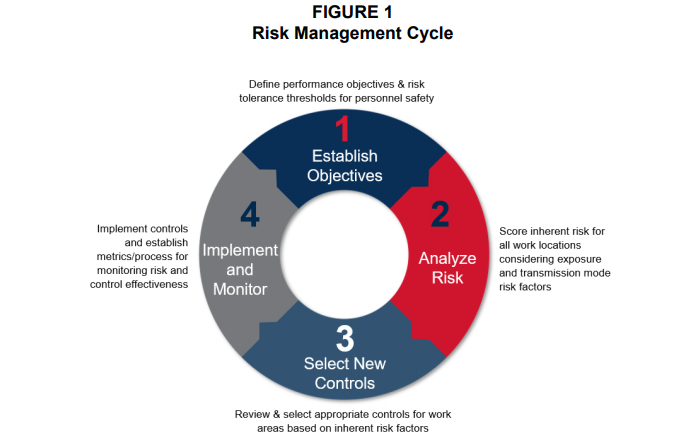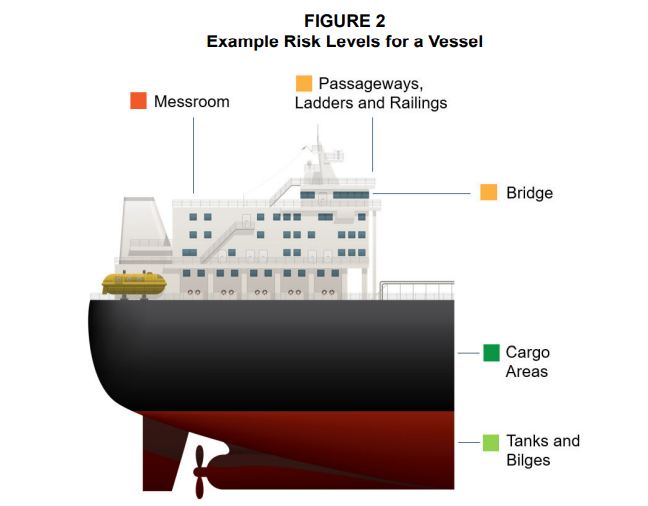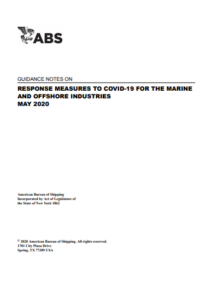ABS has launched guidance on sanitizing and decontaminating marine and offshore assets exposed to COVID-19. Along with focusing on measures to mitigate exposure and response measures, the guidance includes a risk management framework for ships with respect to COVID-19.
The guidance, entitled ‘Response Measures to COVID-19 for the Marine and Offshore Industries’ includes best practice guidelines for sanitizing assets exposed to COVID-19, answering a range of practical questions.
Produced from a maritime public health perspective, the best practices are applicable to commercial and naval vessels, as well as drilling units, production installations and other offshore units.
Marine and offshore operators face the same challenge globally today. Determining how to protect crews while continuing operations in complex environments with unique requirements, where decontamination is considerably more challenging than for assets on land. For instance, improper application of detergents and disinfectants can degrade structural materials or weaken coatings designed to protect structures,
…said Christopher J. Wiernicki, ABS Chairman, President and Chief Executive Officer.
A risk management framework
Risk management is the process of identifying and managing the impact of uncertain events, and bringing the consequences to acceptable levels. The recommended risk-management cycle is comprised of four phases:
- establishing objectives by identifying the strategic goals and determining constraints;
- analyzing the risks;
- selecting controls and evaluating the alternatives to address the risks;
- implementing the alternatives and monitoring the progress and results.
The process organizes information about the possibility of a spectrum of unwanted outcomes into an inclusive, orderly structure that helps decision makers to make informed choices about their organization’s ability to reduce risks.

Phase 1 – Establish Objectives
Phase 1 of the risk-management cycle involves establishing the scope and structure of the decision-making process. Mission-critical steps in this phase include:
-Understanding and Defining the Decision: Specifically describe what decision(s) should be made and what options are available to the decision maker. For example, is the scenario of concern avoiding exposure or dealing with a suspected case of COVID-19 onboard the asset?
–Determine Who Should be Involved: Input from key stakeholders is essential to a sound risk management process. Planners at all levels should identify and solicit input from the stakeholders who should be involved in making the decision, and those who will be affected by actions resulting from the decision-making process.
Also, identify the factors that will influence the decisions. The decision to pursue a given strategy is not based solely on risk. For each individual element within a strategy and for the strategy as a whole, decision makers should weigh a number of factors, including:
- How effective will the strategy be in reducing risk?
- Is it feasible to implement?
- Is it cost efficient?
- How will a risk reduction be measured?
- Will there be likely negative repercussions? If so, what are they?
-Establish Formal Risk Acceptance/Tolerance Criteria: The risk-informed decision-making process relies on an assessment of whether the identified risks are tolerably low. For example, the criteria regarding potential exposure, will be to minimize the potential for crew exposure.
-Establish Common Risk Terminology: A common terminology for risk discussion reduces any poor communication that might lead to gaps and redundancies in the application of risk-informed processes. The definitions in subsection 1/4 may help improving the consistency. All involved stakeholders should be educated about the meanings and operational implications of the terminology.
Phase 2 – Risk Assessment
Risk information fundamentally seeks to help decision-makers answer three critical questions:
i) What can go wrong? In this instance, consider the following two scenarios:
- Scenario 1 – The vessel is not infected by COVID-19 (prevention management scenario)
- Scenario 2 – There is at least one COVID-19 Case aboard (outbreak management scenario)
ii) How likely is it? This is typically captured in the threat and vulnerability analyses.
iii) What are the impacts? This can be impacts to people, property, business interruption, and the environment, among others.
-Determine the Risk-Related Information Needed to Answer the Questions: Describe the information necessary to answer each question posed in the previous step. For each informational item, identify the following:
- Information type needed
- Level of precision required
- Level of certainty required
-Select the Risk Analysis Method and Tool: Risk modeling techniques vary by the cost of use, the level of precision and certainty of output produced (information), and the required quality of input data. Given the high degree of uncertainty during this pandemic, and precision available, a relative ranking/risk indexing approach is suggested. This considers the features of an operation or facility to calculate index numbers that are useful for comparing the risks of different options. However, one should recognize that the calculated index numbers are estimates.
-Establish the Scope for the Analysis: Set any physical or analytical boundaries for the analysis. For example, it may be desirable to perform a separate risk assessment for specific areas of a vessel to include:
- Bridge
- Machinery spaces
- Lockers/storage areas
- Cargo areas, etc.
In addition, the tolerable risk of transmission should be determined. This involves considering whether the vulnerability to infection from performing work in a defined area is tolerable. Other factors to consider are the numbers of people, personnel risk factors (e.g. age, pre-existing medical conditions, etc.), access controls, potential transmission modes (i.e. surfaces, personal contact, airborne) and the likelihood of transmission.
-Generate Risk-Based Information Using the Analysis Method(s) and Tool(s): Apply the risk-analysis tool(s) that were selected. This may involve some iterative analysis (i.e., starting with a high-level assessment and progressing to a more detailed evaluation); or performing separate assessments for a prevention-management scenario and progressing to an outbreak-management scenario. An example of a risk-ranking tool is shown below:



Phase 3 – Alternative Evaluation & Selection
The goal of most decision-making processes is to lower risk as much as possible. Sometimes the risk will be acceptable; at other times, the risk should be reduced to become acceptable. To reduce risk, action should be taken to manage it. These actions should provide more benefit than they cost. They should also be acceptable to stakeholders and not cause other significant risks. Key steps in this process are:
-Develop Alternate Strategies to Manage Risk: The analysis team should engage the stakeholders to determine how the risks for each scenario can be managed most effectively. Examples to consider are cleaning and disinfecting, isolating and quarantine, social distancing, securing contaminated spaces, as well as other operational and organizational measures.
-Assess the Risk Impact of the Proposed Alternatives: The planning team should reassess the risk of each scenario based on the expected effectiveness of the alternatives assuming the implementation of each alternative. This step will characterize risk reduction for each of the alternate strategies. While quantitative estimates of risk reduction might be desired, a qualitative assessment of the alternative will likely be sufficient to inform the planning process.
-Select Risk Management Alternatives: Once the alternatives have been fully developed and their risk reduction value has been described, the risk management process moves to the management selection phase, in which decision makers choose the collection of alternatives for implementation.
[adrotate banner=”313″]Phase 4- Implementation and Monitoring
The risk management process then moves to implementation of the chosen alternatives and the ongoing monitoring to confirm they are functioning as intended. Critical steps in this phase include:
-Implement the Chosen Mitigation Strategies: This step involves the implementation of the alternatives identified during the management selection phase. These will often take the form of a project and require deliberate planning and management of the implementation tasks.
-Develop Metrics to Measure Effectiveness: The implementation team should develop a collection of metrics, both qualitative and quantitative, to measure the effectiveness of the chosen alternative. These may include outcome-oriented metrics, and leading, or lagging indicators.
-Monitor the Performance: After the strategies have been implemented and the metrics have been developed, the asset management should monitor the effectiveness of the actions taken to manage risk.
The goal of the monitoring phase is to verify that the asset is getting the expected results from its risk management decisions. Key inputs into the monitoring phase include testing, crew training, and implementing.
The results of the monitoring step will inform subsequent iterations of the risk management cycle. Real-time monitoring can result in a real-time modification of the actions to improve outcomes and further reduce risk.
Explore more herebelow:





























































